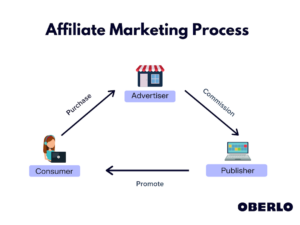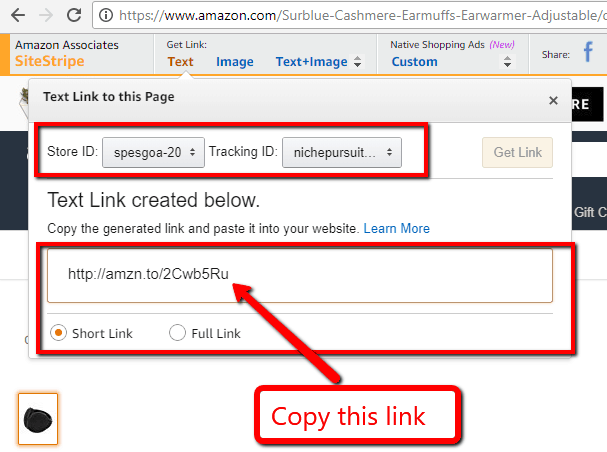
Have you ever wondered how much you can make from using affiliate links on Amazon? Well, you’re not alone! Many people are curious about the potential earnings that can be made through this popular online platform. In this article, we are going to delve into the world of affiliate marketing on Amazon and explore just how much money you can make by leveraging these links.
How Much Can You Make From Affiliate Links On Amazon?
Affiliate marketing has become a popular way for individuals to earn passive income online. By promoting products through affiliate links, you can earn a commission for every sale that is made through your unique link. The great thing about Amazon is the wide variety of products available, giving you endless opportunities to find a niche that aligns with your interests and expertise. In our upcoming article, we will discuss the factors that can impact your earnings, such as the commission rates and the popularity of the products you promote. Stay tuned to learn more about how you can maximize your earnings through affiliate links on Amazon!
What are affiliate links on Amazon?
Affiliate links on Amazon are special links that contain a unique identifier, known as an affiliate ID. These links are used by Amazon’s affiliate program, also known as Amazon Associates, to track the referrals made by affiliates and attribute commissions to them. When a user clicks on an affiliate link and makes a purchase on Amazon, the affiliate who shared the link earns a commission.
Definition and explanation of affiliate links on Amazon
Affiliate links on Amazon are URLs that contain the affiliate ID of an Amazon Associate. These links direct users to specific products or pages on Amazon’s website. When a user clicks on an affiliate link and makes a purchase, the affiliate receives a commission.
Affiliate links are essential for tracking referrals and determining which affiliate should receive commissions for a sale. They ensure that affiliates are appropriately rewarded for their efforts in driving traffic and generating sales for Amazon.
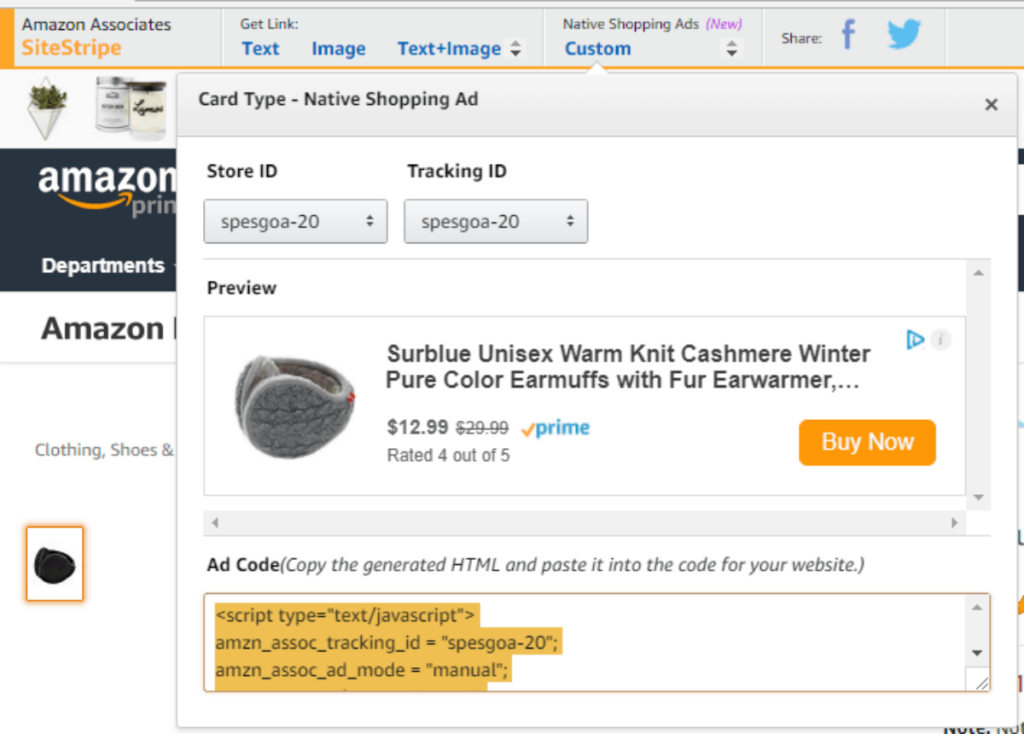
How affiliate links work on Amazon
The process of how affiliate links work on Amazon is fairly straightforward. When you sign up for the Amazon Associates program, you are provided with a unique affiliate ID. This ID is added to the end of any URL on Amazon to create your affiliate link.
For example, if you want to promote a specific product, you would take the regular product URL on Amazon and append your affiliate ID to it. When someone clicks on your affiliate link, they are redirected to the product page on Amazon. If they make a purchase within a specified window of time, typically 24 hours, you will earn a commission on that sale.
The tracking of affiliate links is done through cookies. When a user clicks on an affiliate link, a cookie is stored on their device. This cookie contains information that identifies the affiliate who referred the user. If the user makes a purchase within the cookie’s expiration window, the affiliate is credited with the sale.
How to become an Amazon affiliate?
Becoming an Amazon affiliate, or Amazon Associate, is a relatively simple process. However, there are certain requirements that need to be met before you can sign up and start earning money through affiliate links on Amazon.
Requirements to become an Amazon affiliate
To become an Amazon affiliate, you need to meet the following requirements:
- Have a website, blog, or social media platform where you intend to promote Amazon products.
- Be at least 18 years old or have the legal capacity to enter into contracts in your jurisdiction.
- Have a valid mailing address.
- Be located in an eligible country where the Amazon Associates program is available.
Steps to sign up and become an Amazon affiliate
To sign up as an Amazon affiliate, follow these steps:
- Go to the Amazon Associates website.
- Click on the “Join Now for Free” button.
- Sign in to your Amazon account or create a new one.
- Fill out the required information, such as your website URL, preferred store ID, and payment method.
- Read and agree to the Amazon Associates Operating Agreement.
- Provide tax information, if applicable.
- Submit your application and wait for approval from Amazon.
Once approved, you will have access to your Amazon affiliate dashboard, where you can generate affiliate links and track your earnings.

Understanding affiliate commissions on Amazon
Affiliate commissions on Amazon are the earnings that affiliates receive for each qualified purchase made through their affiliate links. Understanding how affiliate commissions are calculated and the different types of commissions available is crucial for maximizing your earnings as an Amazon affiliate.
Different types of affiliate commissions on Amazon
Amazon offers different commission rates based on the product category. The percentage of commission earned varies depending on the type of product being sold. For example, Amazon typically offers a higher commission rate for luxury beauty products compared to electronics.
Additionally, Amazon has a fixed standard commission structure for certain product categories. For instance, the commission rate for Amazon devices such as Kindle e-readers and Echo devices is set at a fixed percentage.
How Amazon calculates affiliate commissions
Amazon calculates affiliate commissions based on the value of the product purchased through the affiliate link. The commission rate is applied to the net sale price, which is the product’s price after deducting any discounts, promotions, or returns.
It’s important to note that certain products, such as digital content and gift cards, may not be eligible for earning affiliate commissions. Additionally, the commission rate may vary depending on the country in which the sale was made.
Factors that affect affiliate commissions
Several factors can affect the amount of affiliate commissions you earn on Amazon. These factors include:
- Product Category: The commission rates vary by product category, so promoting products with higher commission rates can result in higher earnings.
- Sales Volume: Amazon offers a performance-based tiered commission structure, which means that affiliates who generate more sales earn higher commission rates.
- Customer Behavior: The average order value, repeat purchases, and the types of products customers buy through your affiliate links can influence your overall commission earnings.
- Conversion Rate: The conversion rate, which is the percentage of users who click on your affiliate link and make a purchase, can impact your earnings. High-converting products can result in more commissions.
- Seasonality: The demand for certain products may fluctuate throughout the year, affecting the number of sales and commissions earned during different seasons.
Determining the potential earnings from affiliate links on Amazon
Estimating the potential earnings from affiliate links on Amazon can help you set realistic goals and create a strategy to maximize your revenue. Several factors need to be considered when evaluating the earning potential of affiliate links on Amazon.
Factors to consider when estimating potential earnings
- Commission Rates: Understanding the commission rates for different product categories can give you an idea of the potential earnings. Higher commission rates can lead to more significant income per sale.
- Audience Size: The size and engagement of your audience can influence the amount of traffic you can drive to Amazon and the number of potential purchases.
- Conversion Rate: The conversion rate, or the percentage of users who make a purchase after clicking on your affiliate link, is a critical factor in estimating your earnings. A higher conversion rate can result in more commissions.
- Average Order Value: The average amount customers spend per order affects your earnings. Promoting higher-priced products can result in higher commission amounts.
- Content Quality: Creating high-quality, engaging, and informative content can attract more visitors and increase the likelihood of conversions and sales.
Using the Amazon Affiliate Program Fee Schedule
Amazon provides an Affiliate Program Fee Schedule that outlines the commission rates for different product categories. This resource can help you estimate your potential earnings based on the product categories you plan to promote. The Fee Schedule is regularly updated by Amazon to reflect any changes in commission rates.
By referring to the Fee Schedule and considering the factors mentioned above, you can calculate an estimate of your potential earnings from affiliate links on Amazon.
Evaluating the popularity and demand of products
Assessing the popularity and demand of products can also impact potential earnings. Popular products with high demand are more likely to generate sales and result in commissions. You can use market research tools, conduct keyword research, and explore trends to identify products that have a higher likelihood of being purchased through your affiliate links.
Understanding the needs and interests of your target audience can help you select products that align with their preferences, increasing the chances of generating sales and earning commissions.
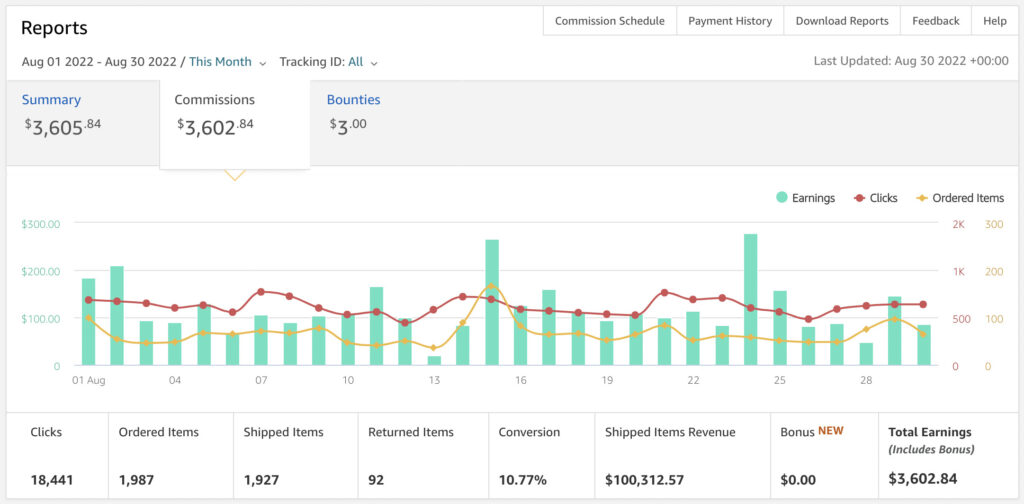
Strategies to maximize your earnings
While the potential earnings from affiliate links on Amazon can be significant, implementing effective strategies is crucial to maximize your income. Here are some strategies that can help you increase your earnings as an Amazon affiliate.
Choosing high-converting products
Selecting products with a high conversion rate is essential for maximizing your earnings. Look for products that have positive customer reviews, high ratings, and a proven track record of generating sales. Additionally, consider promoting products that are relevant to your niche or target audience, as they are more likely to be purchased.
To determine the conversion rate of products, you can review the Product Linking Report in your Amazon affiliate dashboard. This report provides insights into the number of clicks received and the resulting sales for each product.
Utilizing product reviews and comparisons
Writing product reviews and comparisons can be an effective way to drive traffic to your affiliate links and increase your chances of earning commissions. By providing detailed and unbiased information about products, you can help potential buyers make informed purchasing decisions.
Ensure that your product reviews and comparisons are honest, thorough, and based on personal experiences or thorough research. Highlighting the features, benefits, and drawbacks of products can help users make an informed decision, increasing the likelihood of a purchase through your affiliate link.
Promoting affiliate links through multiple channels
To reach a larger audience and generate more sales, it’s important to promote your affiliate links through various channels. Below are some examples of channels you can utilize:
Using website or blog
If you have a website or blog, you can create engaging and informative content that incorporates your affiliate links. Write articles, blog posts, or tutorials that provide value to your readers and incorporate affiliate links naturally within the content.
Leveraging social media platforms
Utilize social media platforms such as Facebook, Instagram, Twitter, or Pinterest to promote products and share your affiliate links. Create visually appealing posts, share product recommendations, and engage with your audience to generate interest and drive traffic to your affiliate links.
Email marketing and newsletters
If you have an email list or newsletter subscribers, you can promote products and share your affiliate links via email. Craft compelling emails that highlight the benefits of products and provide exclusive offers or discounts to encourage click-throughs and conversions.
YouTube videos and tutorials
Creating YouTube videos or tutorials that feature products and include your affiliate links can be a highly effective strategy. Visual demonstrations and personal recommendations can be persuasive and drive viewers to purchase products through your affiliate links.
Choose the channels that are most relevant to your niche and target audience, and consistently create engaging content to promote your affiliate links.
Creating engaging and valuable content
Content is king when it comes to affiliate marketing. Creating valuable and engaging content that provides useful information, solves problems, or entertains your audience can help build trust and credibility.
Focus on creating content that educates, inspires, or entertains your audience. By providing value, you can attract more visitors to your website or social media platforms, increase engagement, and encourage click-throughs on your affiliate links.
Remember to disclose your affiliate relationship clearly within your content to ensure transparency and build trust with your audience.
Promoting affiliate links through various platforms
Promoting your affiliate links through various platforms can help you reach a wider audience and increase your chances of earning commissions.
Using a website or blog
Having a dedicated website or blog is an effective way to promote your affiliate links. Create high-quality content that incorporates your affiliate links naturally within the text. Write blog posts, product reviews, tutorials, or gift guides that provide value to your readers and encourage them to make a purchase through your affiliate links.
Optimize your website or blog for search engines to attract organic traffic and increase the visibility of your affiliate links. Utilize relevant keywords, meta tags, and quality backlinks to improve your search engine rankings.
Leveraging social media platforms
Social media platforms offer a vast audience reach and can be utilized to promote your affiliate links effectively. Create engaging and visually appealing posts that highlight products and include your affiliate links.
Use platforms like Facebook, Instagram, Twitter, and Pinterest to share product recommendations, offer exclusive discounts or deals, and engage with your audience. Incorporate hashtags and relevant keywords to increase the visibility of your posts and drive traffic to your affiliate links.
Email marketing and newsletters
If you have an email list or a newsletter subscription base, you can leverage this platform to promote your affiliate links effectively. Craft compelling emails that showcase products, provide exclusive offers or discounts, and drive recipients to click on your affiliate links.
Segment your email list based on the interests and preferences of your subscribers to send targeted promotions that are more likely to result in conversions. Personalize your emails and make them conversational to build a connection with your subscribers and increase the chances of click-throughs.
YouTube videos and tutorials
YouTube is the second largest search engine after Google, and creating video content can be a highly effective way to promote your affiliate links. Create tutorials, product reviews, or informative videos that include your affiliate links in the video description or as clickable overlays within the video.
Optimize your video titles, descriptions, and tags with relevant keywords to improve the visibility of your videos in search results. Engage with your viewers, respond to comments, and encourage them to subscribe to your channel for more product recommendations and updates.
Choose the platforms that align with your target audience and niche, and consistently create valuable and engaging content to promote your affiliate links.
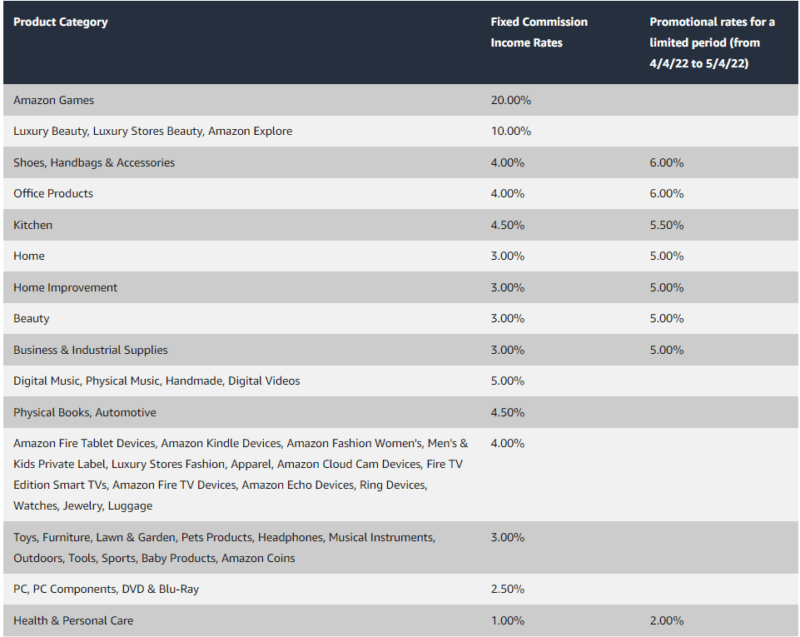
Understanding Amazon’s affiliate policies and guidelines
To ensure a successful and compliant affiliate marketing experience on Amazon, it’s crucial to understand and follow Amazon’s affiliate policies and guidelines.
Overview of Amazon’s affiliate policies
Amazon has a set of policies and guidelines that affiliates must adhere to when promoting products and generating sales. Some key policies include:
- Disclosing Affiliate Status: You must disclose your relationship with Amazon as an affiliate by using appropriate disclosure statements on your website, social media posts, or any other platform where you promote affiliate links.
- Prohibited Content: Amazon prohibits promoting its products through certain types of content, such as adult content, violent content, or content that violates intellectual property rights.
- Prohibited Marketing Methods: Certain marketing methods, such as incentivized clicks, cookie stuffing, or misleading advertisements, are prohibited by Amazon.
- Trademark Usage: Proper usage of Amazon’s trademarks, logos, and branding materials is important to comply with Amazon’s policies.
By familiarizing yourself with Amazon’s affiliate policies and ensuring compliance, you can protect your affiliate account and maintain a long-term partnership with Amazon.
Prohibited activities and practices
Amazon has strict guidelines on prohibited activities and practices that affiliates must avoid. Some prohibited practices include:
- Offering cashbacks or rebates to customers in exchange for using your affiliate links.
- Using misleading tactics, such as false scarcity or fake discounts, to entice users to make purchases through your affiliate links.
- Including affiliate links in unsolicited email communications or spamming users with promotional content.
- Masking or cloaking affiliate links in a way that violates Amazon’s policies or deceives users.
Engaging in any of these prohibited activities can result in the termination of your affiliate account and the loss of any earned commissions.
Ensuring compliance with the guidelines
To ensure compliance with Amazon’s affiliate policies and guidelines, carefully review and familiarize yourself with the terms of the Amazon Associates Operating Agreement. Monitor your promotional activities regularly to ensure they align with Amazon’s policies.
Additionally, periodically review Amazon’s policy updates and stay informed about any changes that may affect your affiliate marketing practices. By staying up-to-date and compliant, you can maintain a long-term and successful partnership with Amazon.
Tracking and analyzing affiliate link performance
Tracking and analyzing the performance of your affiliate links on Amazon is crucial for optimizing your strategy and maximizing your earnings. By monitoring key metrics and analyzing data, you can identify areas for improvement and make data-driven decisions.
Importance of tracking link performance
Tracking the performance of your affiliate links allows you to gain insights into the effectiveness of your promotional efforts. Understanding which links are generating the most clicks, conversions, and revenue can help you identify successful strategies and prioritize your marketing efforts.
Additionally, tracking link performance helps you measure the return on investment (ROI) of your affiliate marketing efforts. It allows you to assess the profitability of different promotional channels, identify high-converting products, and allocate resources accordingly.
Tools and methods for tracking affiliate links
Amazon provides several tracking tools and reports to help you monitor the performance of your affiliate links. These tools include:
- Amazon Affiliate Dashboard: The Amazon Associates dashboard provides a summary of your account activity, including clicks, conversions, and earnings. It allows you to generate affiliate links, track performance, and access reports.
- Product Linking Report: The Product Linking Report provides detailed information on each product you promote. It shows the number of clicks, items ordered, conversion rate, and earnings for each product, allowing you to evaluate the performance of individual products.
- SiteStripe: SiteStripe is a toolbar available to Amazon affiliates that allows you to generate affiliate links and track performance directly from Amazon’s website. It provides a quick and convenient way to create affiliate links for products and pages.
In addition to these Amazon-specific tools, you can also utilize third-party affiliate tracking platforms, such as Google Analytics or affiliate marketing plugins, to gain more comprehensive insights into your link performance.
Analyzing data to optimize performance
Analyzing the data from your tracking tools is essential for optimizing affiliate link performance. By identifying trends, patterns, and areas of improvement, you can refine your promotional strategies and maximize your earnings.
Some key performance metrics to analyze include:
- Click-Through Rate (CTR): CTR measures the percentage of users who click on your affiliate links after being exposed to them. A low CTR may indicate that your promotional methods or content need improvement.
- Conversion Rate: Conversion rate measures the percentage of visitors who make a purchase after clicking on your affiliate link. Analyzing the conversion rate can help you identify high-converting products, optimize your landing pages, and improve your overall conversion rate.
- Earnings Per Click (EPC): EPC represents the average earnings you earn per click. By analyzing the EPC for different products, you can identify the most profitable items to promote.
- Traffic Sources: Analyzing the sources of your traffic can help you understand which channels are driving the most clicks and conversions. This insight allows you to allocate resources effectively and focus on the channels that generate the highest return on investment.
By regularly tracking and analyzing these metrics, you can identify trends, optimize your promotional strategies, and make data-driven decisions to improve the performance of your affiliate links on Amazon.

Dealing with challenges and overcoming obstacles
While affiliate marketing on Amazon can be a lucrative opportunity, it’s not without its challenges. Understanding these challenges and knowing how to overcome them is essential for long-term success as an Amazon affiliate.
Increasing competition among affiliates
As the popularity of affiliate marketing grows, so does the competition among affiliates. With more people promoting the same products and targeting the same audiences, it can be challenging to stand out and capture the attention of potential buyers.
To overcome this challenge, focus on differentiating yourself through unique content, in-depth product reviews, or exclusive promotions. Offer value to your audience by providing helpful information, solving their problems, or offering additional resources.
Additionally, consider targeting niche audiences or specific product categories that have lower competition. By identifying untapped markets, you can increase your chances of attracting customers and generating sales.
Adapting to changes in Amazon’s affiliate program
Amazon’s affiliate program is subject to occasional changes in commission rates, policies, or program structure. These changes can affect your earnings and require you to adapt your affiliate marketing strategies.
Stay informed about any updates or changes to Amazon’s affiliate program by regularly reviewing the Amazon Associates website, blog, or newsletters. Being aware of these changes allows you to pivot your strategies, explore new product categories with higher commission rates, or adjust your promotional methods accordingly.
Dealing with low conversion rates
Low conversion rates can be a common challenge for affiliates, especially when starting or promoting certain products. Low conversion rates may be due to various factors, such as ineffective marketing methods, low-quality traffic, or a mismatch between your audience and the products being promoted.
To improve your conversion rates, consider the following strategies:
- Improve Your Content: Focus on creating high-quality content that provides value to your audience and builds trust. Engaging and informative content can increase the chances of conversion.
- Optimize Your Landing Pages: Optimize your landing pages to provide a seamless user experience and encourage conversion. Ensure that your landing pages are visually appealing, load quickly, and contain compelling calls-to-action.
- Test Different Promotional Methods: Try different promotional methods to identify what works best for your audience. Experiment with different platforms, content types, or promotional strategies to find the most effective approach.
- Refine Your Targeting: Review your target audience and ensure that the products you promote align with their preferences and needs. Narrowing down your target audience can result in more relevant traffic and higher conversion rates.
It’s important to remember that conversion rates can vary depending on various factors, including the types of products being promoted, the quality of your traffic, and the strength of your content. Continuously monitor and analyze your performance metrics to identify areas for improvement and make adjustments to optimize your conversion rates.
Exploring alternative affiliate programs and networks
While Amazon’s affiliate program is one of the most popular and lucrative options for affiliate marketing, there are other affiliate programs and networks worth exploring. Diversifying your affiliate marketing efforts can provide additional income streams and reduce reliance on a single platform.
Other popular affiliate programs and networks
Some alternative affiliate programs and networks to consider include:
- eBay Partner Network: eBay offers an affiliate program that allows you to earn commissions by promoting eBay listings. It offers competitive commission rates and a wide range of product categories.
- ShareASale: ShareASale is a popular affiliate network that connects affiliates with various merchants across different industries. It offers a wide range of products to promote and provides robust tracking and reporting tools.
- Commission Junction: Commission Junction, also known as CJ Affiliate, is an affiliate network that partners with numerous well-known brands. It offers a vast selection of products to promote and provides access to advanced tracking and reporting features.
- Rakuten Advertising: Rakuten Advertising is a global affiliate network that provides access to a wide range of merchants and brands. With Rakuten Advertising, you can promote products from well-known retailers and earn commissions based on performance.
Pros and cons of different options
Each alternative affiliate program or network has its own set of pros and cons. Some factors to consider when exploring alternatives include:
- Commission rates: Compare the commission rates offered by different programs to ensure they align with your earning goals.
- Product selection: Assess the product categories and availability of products that match your niche and target audience.
- Tools and resources: Evaluate the tracking, reporting, and promotional tools offered by each program or network to ensure they meet your requirements.
- Reputation and reliability: Research the reputation and reliability of the program or network, including feedback from affiliates who have used their services.
By diversifying your affiliate marketing efforts and exploring alternative programs and networks, you can tap into different audiences, product categories, and promotional strategies, increasing the potential for earnings.
Tips for success as an Amazon affiliate
Becoming a successful Amazon affiliate requires more than just generating traffic and earning commissions. Consider the following tips to maximize your success and increase your earnings as an Amazon affiliate.
Consistency and persistence
Consistency and persistence are key to long-term success as an Amazon affiliate. Building a successful affiliate marketing business takes time and effort. Consistently create high-quality content, promote products through various channels, and engage with your audience to build trust and recognition.
It’s important to remember that success does not happen overnight. Stay consistent with your promotional efforts, be patient, and continuously refine your strategies to achieve your goals.
Building a loyal audience
Building a loyal audience is crucial for sustainable success as an Amazon affiliate. Focus on providing value to your readers or viewers by creating content that educates, entertains, or solves their problems. Building trust and a positive relationship with your audience can result in repeat sales, higher conversion rates, and increased earnings.
Engage with your audience through comments, social media interactions, or email responses. By building a community around your content and affiliate links, you can foster loyalty and encourage long-term engagement.
Continuously learning and adapting strategies
The field of affiliate marketing is constantly evolving, and staying up-to-date with industry trends and strategies is essential for success. Continuously educate yourself by reading blogs, attending webinars, or participating in relevant forums or communities.
Stay open to new ideas and adapt your strategies based on the changing landscape of affiliate marketing. Test different promotional methods, try new platforms, and analyze the results to optimize your performance.
By staying informed and continuously learning, you can stay ahead of the competition and maximize your earnings as an Amazon affiliate.
Success stories and examples of high-earning Amazon affiliates
There are numerous success stories and examples of individuals who have achieved significant earnings as Amazon affiliates. These examples serve as inspiration and demonstrate the potential for making money through affiliate links on Amazon.
Case studies of successful Amazon affiliate marketers
Case studies of successful Amazon affiliate marketers provide valuable insights into their strategies, promotional methods, and the factors contributing to their success. By studying these cases, you can learn from their experiences, replicate their successes, and avoid common mistakes.
Some well-known case studies include:
- The Wirecutter: The Wirecutter is a popular affiliate website that provides in-depth product reviews and buying guides. The Wirecutter’s success lies in its focus on high-quality, detailed content that helps users make informed purchasing decisions.
- Authority Hacker: Authority Hacker is a website and podcast that offers insights and strategies for building successful affiliate marketing businesses. The founders, Gael Breton and Mark Webster, have built multiple successful affiliate sites, including sites in the health and gaming niches.
- Niche Pursuits: Niche Pursuits is a blog and podcast by Spencer Haws, who shares his experiences and strategies for building successful niche affiliate sites. Spencer has achieved significant success by identifying profitable niches and creating valuable content.
Inspiring examples of high-earning affiliates
There are numerous examples of individuals who have achieved significant earnings as Amazon affiliates. These inspiring examples demonstrate the potential for making substantial income from affiliate links on Amazon.
Some notable examples include:
- Pat Flynn: Pat Flynn, the founder of Smart Passive Income, has built a highly successful online business that generates income from multiple sources, including affiliate marketing. Pat has consistently shared his earnings and strategies, serving as an inspiration to aspiring affiliates.
- Michelle Schroeder-Gardner: Michelle Schroeder-Gardner, the founder of Making Sense of Cents, is known for earning a significant income through affiliate marketing, including Amazon’s affiliate program. She shares her experiences and strategies through her blog, inspiring others to achieve similar success.
- John Lee Dumas: John Lee Dumas, the host of the Entrepreneur on Fire podcast, has successfully monetized his podcast through affiliate marketing. His energetic and engaging approach to promoting products has resulted in significant earnings as an Amazon affiliate.
These examples highlight the potential for building a successful and profitable affiliate marketing business with Amazon. While these individuals have achieved exceptional results, it’s important to remember that success is relative and varies depending on numerous factors, including niche, effort, and audience.
Conclusion
Affiliate marketing through Amazon can be a lucrative opportunity for earning money through affiliate links. By understanding how affiliate links work, meeting the requirements to become an Amazon affiliate, and implementing effective strategies, you can maximize your earnings.
Factors such as commission rates, conversion rates, and the popularity of products all play a role in determining your potential earnings. By estimating your potential earnings and using tracking and analysis tools, you can optimize your performance and make data-driven decisions.
While challenges such as competition and low conversion rates exist, adapting to changes, exploring alternative affiliate programs, and implementing best practices can help you overcome obstacles and increase your earnings.
By staying consistent, building a loyal audience, and continuously learning, you can increase your chances of success as an Amazon affiliate. Success stories and examples of high-earning affiliates serve as inspiration and remind us of the potential for making money through affiliate links on Amazon.
In conclusion, with the right strategies, dedication, and continuous improvement, you can harness the potential of affiliate links on Amazon and create a successful and profitable affiliate marketing business.
Check out my YouTube channel for more tips.
This post was made with AIWiseMind. Click here to learn more.
